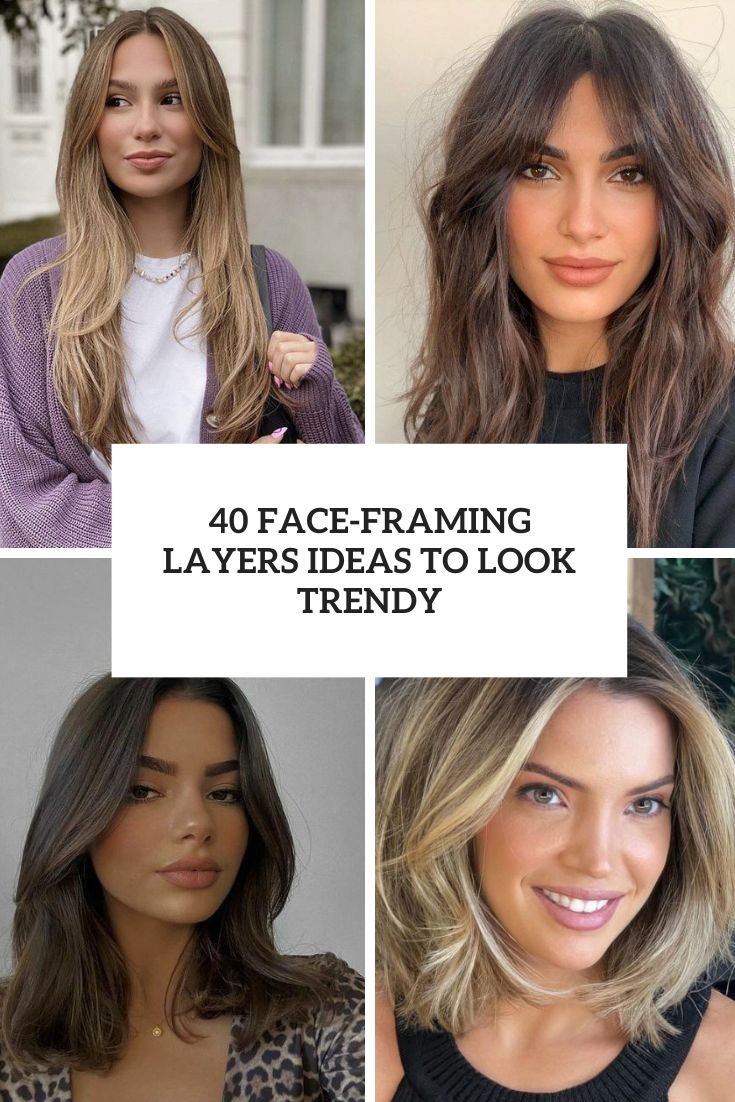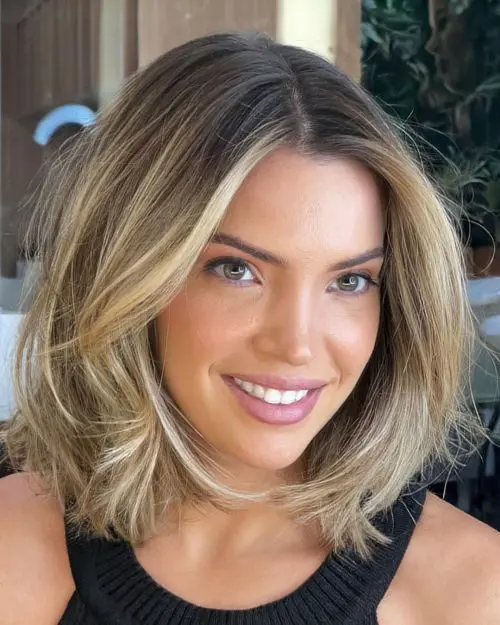If you're on the hunt for the perfect hairstyle that complements your wavy hair, face framing layers might just be the answer you've been searching for. With their ability to enhance your natural texture and frame your facial features beautifully, these layers have become a favorite among hairstylists and hair enthusiasts alike. Whether you're looking to add volume, definition, or simply want a fresh look, face framing layers offer versatility and style.
Wavy hair is known for its unique texture, which can sometimes be unpredictable. However, with the right technique and styling, it can be transformed into a stunning mane that highlights your best features. Face framing layers are specifically designed to work with wavy hair, providing structure and movement that complements your natural waves.
In this comprehensive guide, we'll explore everything you need to know about face framing layers for wavy hair. From understanding the benefits to learning how to maintain them, we've got you covered. Let's dive in and discover how this hairstyle can elevate your look!
Read also:Best Colostrum The Ultimate Guide To Boosting Your Health
Table of Contents
- What Are Face Framing Layers?
- Benefits of Face Framing Layers for Wavy Hair
- Choosing the Right Length for Your Face Framing Layers
- Styling Tips for Face Framing Layers
- Products to Use for Wavy Hair with Layers
- Maintenance and Care for Face Framing Layers
- Common Mistakes to Avoid
- Professional Advice on Face Framing Layers
- Frequently Asked Questions
- Conclusion
What Are Face Framing Layers?
Face framing layers refer to a specific haircut technique where layers are strategically placed around the face to enhance its natural shape and features. These layers are typically shorter than the rest of the hair and are designed to create a frame around the face, adding dimension and movement. For individuals with wavy hair, face framing layers can help define and control the natural texture, giving it a polished and stylish appearance.
How Do Face Framing Layers Work?
When applied to wavy hair, face framing layers work by balancing the volume and texture of your mane. By cutting layers at varying lengths, hairstylists can control how the waves fall, ensuring they frame the face beautifully. This technique not only enhances the natural texture of your hair but also draws attention to your best facial features, such as your eyes, cheekbones, and smile.
Why Are Face Framing Layers Ideal for Wavy Hair?
Wavy hair often benefits from layers because they help reduce frizz and add definition to the waves. Face framing layers, in particular, provide a structured look that complements the natural movement of wavy hair. They also help in managing the volume, ensuring that your hair doesn't look too heavy or overwhelming.
Benefits of Face Framing Layers for Wavy Hair
Face framing layers offer numerous advantages for those with wavy hair. Below are some of the key benefits:
Read also:Cast The Choice Your Ultimate Guide To Exploring The World Of Casting Choices
- Enhanced Texture: Layers add definition to your waves, making them appear more pronounced and defined.
- Volume Control: By cutting layers around the face, hairstylists can control the volume of your hair, preventing it from looking too bulky.
- Flattering Appearance: Face framing layers are designed to complement your facial features, creating a harmonious and balanced look.
- Easy Maintenance: Once styled correctly, face framing layers require minimal upkeep, making them ideal for busy lifestyles.
Choosing the Right Length for Your Face Framing Layers
Selecting the appropriate length for your face framing layers depends on several factors, including your face shape, hair type, and personal preferences. Here are some guidelines to help you make the right choice:
Face Shape Considerations
Different face shapes benefit from varying lengths of face framing layers:
- Oval Face: Almost any length works well, as the symmetry of an oval face allows for versatility.
- Round Face: Opt for longer layers that elongate the face and create a slimming effect.
- Square Face: Choose softer, rounded layers to soften sharp angles.
- Heart-Shaped Face: Focus on layers around the jawline to balance the wider forehead.
Hair Type Considerations
Your hair type also plays a crucial role in determining the ideal length:
- Thick Wavy Hair: Shorter layers can help reduce bulk and add movement.
- Thin Wavy Hair: Longer layers can add volume and prevent the hair from looking too sparse.
Styling Tips for Face Framing Layers
Once you've gotten your face framing layers, it's essential to know how to style them properly to maximize their benefits. Here are some tips to help you achieve the best results:
1. Embrace Your Natural Waves
One of the greatest advantages of face framing layers is their ability to enhance your natural waves. Use a styling product that promotes wave definition, such as a sea salt spray or a wave-enhancing mousse.
2. Use Heat Tools Sparingly
While heat tools can help shape your waves, overusing them can lead to damage. Instead, try air-drying your hair or using a diffuser to set your style.
3. Finish with a Light Serum
A light serum or oil can add shine and control frizz, ensuring your face framing layers look polished and sleek.
Products to Use for Wavy Hair with Layers
Choosing the right products can make a significant difference in how your face framing layers turn out. Here are some recommendations:
- Sea Salt Spray: Adds texture and enhances natural waves.
- Waving Cream: Defines curls and provides hold without stiffness.
- Anti-Frizz Serum: Keeps frizz at bay and adds shine.
- Diffuser Attachment: Helps set waves without causing damage.
Maintenance and Care for Face Framing Layers
To keep your face framing layers looking their best, regular maintenance is essential. Here are some tips for caring for your new hairstyle:
Regular Trims
Schedule regular trims every 8-12 weeks to keep your layers fresh and prevent split ends.
Deep Conditioning
Wavy hair can be prone to dryness, so deep conditioning treatments are crucial. Use a hydrating mask once a week to keep your hair soft and healthy.
Common Mistakes to Avoid
While face framing layers can be a game-changer for wavy hair, there are some common mistakes to watch out for:
- Over-Styling: Using too many products or heat tools can lead to damage and loss of natural texture.
- Inconsistent Trims: Neglecting regular trims can cause your layers to lose definition over time.
- Ignoring Hair Health: Focusing solely on styling without caring for the health of your hair can lead to breakage and dullness.
Professional Advice on Face Framing Layers
Hair experts recommend consulting with a professional hairstylist before getting face framing layers. They can assess your hair type and face shape to determine the best approach. Additionally, they can provide personalized advice on how to style and maintain your layers for optimal results.
Frequently Asked Questions
Here are some common questions about face framing layers for wavy hair:
Q: Can face framing layers work for all hair types?
A: Yes, face framing layers can be adapted to suit various hair types, including wavy, curly, and straight hair.
Q: How often should I get my face framing layers trimmed?
A: It's recommended to get a trim every 8-12 weeks to maintain the shape and definition of your layers.
Q: Can I achieve face framing layers at home?
A: While it's possible to cut layers at home, it's best to leave it to a professional to ensure precision and avoid damaging your hair.
Conclusion
Face framing layers for wavy hair offer a versatile and stylish solution for enhancing your natural beauty. By choosing the right length, using the appropriate products, and maintaining your hairstyle regularly, you can enjoy a look that complements your unique features. Whether you're looking to add volume, control frizz, or simply want a fresh new style, face framing layers are a fantastic option.
We invite you to share your experience with face framing layers in the comments below. Have you tried this hairstyle? What tips would you recommend to others? Don't forget to explore our other articles for more hair care advice and inspiration!



